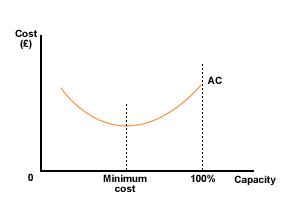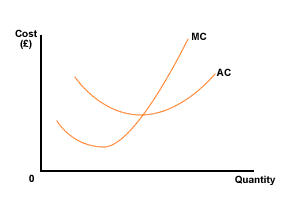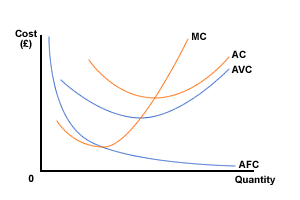Calculating costs
You also need to be able to calculate a firm's costs from given data, be able to draw cost curves and then interpret what they mean. We come to that skill later.
You will also need to identify and explain short-run and long-run cost curves. Look carefully at the following examples.

Figure 3 Short-run average cost curve

Figure 4 Long-run average cost curve
In the short-run, at least one factor input is fixed. In the long-run all inputs are variable. This means that short-run curves are models of what is happening. Long-run curves are planning data. A firm cannot operate with all inputs variable. Having decided what it wants from an examination of the long-run curves, the firm makes a decision to fix a factor, usually capital, and this gives rise to a new short-run situation.
Now, the calculations and the drawing!
You could be presented with data in the form of a table, like the one below
| Output (units | 0 | 1 | 2 | 3 | 4 | 5 | 6 | 7 | 8 | 9 | 10 |
|---|---|---|---|---|---|---|---|---|---|---|---|
| Total cost ($k) | 100 | 110 | 125 | 145 | 170 | 200 | 235 | 275 | 320 | 370 | 425 |
Plot this with output on the horizontal axis and total cost on the vertical axis and look at it.
There is also a static version of this graph available.
What do you know now?
- The firm has fixed costs of $100,000, the cost of 'output zero'.
- The total variable cost is increasing with increasing output

Now, some more sums. Work out the average cost (TC / output), the total variable cost (TC - FC), the variable cost (TVC / output), the average fixed cost (FC / Output) and the marginal cost (TC (Qx) - TC (Qx-1)).
Once you have had a go at calculating all these, follow the answer link below to compare how you got on.
Answer - cost calculations
Now plot this data on two separate graphs as follows, and see what it shows.
Graph 1 - Total cost, total variable costs and total fixed costs
Graph 2 - Marginal cost, average cost, average fixed cost and average variable cost
You should get the following:
Graph 1 Total cost, total variable costs and total fixed costs
There is also a static version of this graph available.
Graph 2 - Marginal cost, average cost, average fixed cost and average variable cost
There is also a static version of this graph available.
- Average cost (AC) falls initially, then turns and starts to rise.
- AFC + AVC = AC.
- MC follows the same pattern, but at a more exaggerated rate.
- Marginal cost and average cost cross at the minimum average cost.
See Figure 6 below for the standard representation of these curves.
Why do average and marginal cost cross at the minimum point of average cost?
Well think of this in terms of cricket scores. Your last innings is your 'marginal' innings, whereas your batting average is your 'average'. Say your average is 50 and in your next innings you get 20 runs. What happens to your average? It will fall. However, if in your next innings you get 80 runs. In this case your average will rise.
So, if the marginal is below the average, the average will fall and if the marginal is above the average, the average will rise.
There are many questions for you to work on in the questions section (click on the questions - module 2 link in the left hand navigation bar). It may also be worth having a look at the Diggin' diagrams sections (accessible from the course homepage) to check how well you understand your diagrams.
Summary
Remember, a standard marginal and average cost curve diagram should look like this:

Figure 5 Marginal and average cost
Add in the average fixed and average variable cost curves and it should look like this:

Figure 6 Marginal cost, average cost, average fixed cost and average variable cost
